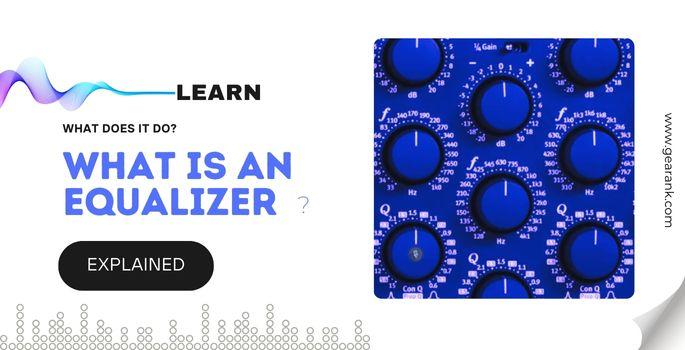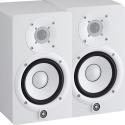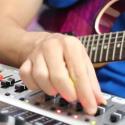What is an Equalizer? You Need To Read This

An equalizer, or EQ, shapes a mix's sound. By adjusting the frequencies of different audio signals, you can achieve a balanced, natural-sounding mix that will translate across any sound system.
Whether mixing music in a live setting, producing tracks in recording studios, or listening to tunes through car audio speaker systems, using an EQ can help you get the most out of your recordings.
This guide will explain what an equalizer is, how it works, and why it is important to use one - Read on to learn how to tell your graphic equalizer from your low pass filters and your frequency band from your shelter filter.
What is An Equalizer?
If you understand what eq in music is, you next need to consider the definition of an equalizer. In the simplest terms, equalizers are devices that adjust the volume or intensity of specific frequency ranges within an audio recording. This allows producers and engineers to make subtle changes, drastically improving sound quality.
Equalizers come in various shapes and sizes, from processor plugins to hardware units. Each type has unique advantages, so choosing the one that works best for your application is essential.
What Are Frequencies?
Frequencies are the sound waves that our ears can hear. They are measured in Hertz (Hz) and range from 20 Hz to 20 kHz (20,000 Hz). Most instruments have a range of frequencies that they produce.
However, some instruments may be limited to specific ranges, and Audio equalization refers to adjusting the frequency balance within an electrical signal.
These frequencies will vary depending on the instrument or sound source, and it is important to understand what frequencies an instrument or sound source produces to mix it correctly.
Lower frequency bands are those under 500 Hz, mid frequencies are between 500-2,000 Hz, and higher frequency bands are anything over 2,000 Hz. Most instruments have a range covering all of these frequency ranges, although some may emphasize certain ones, such as high or lower frequencies, more than others.
Center frequency refers to the frequency, or range of frequencies, around which an equalizer is set. It is typically the main frequency that the equalizer emphasizes or cuts out.
This is often referred to as the "Q" value, and it will vary depending on the type of EQ you are using - some EQs have fixed Q values, while others allow you to adjust them manually. Those with variable Qs let you adjust center frequencies as you see fit.
The center frequency can be adjusted to emphasize or cut out specific frequencies. For example, if you want to reduce the bass frequency in your mix, you can set the center frequency at a lower value, such as 50 Hz. This would result in the EQ cutting out all low frequencies below 50 Hz while leaving everything else untouched. A deeper knowledge of bass eq can help with your music production.
By understanding what sound frequencies different instruments produce, producers can use an equalizer to shape their sound in various ways.
For example, they can cut out unwanted frequencies or boost frequencies to make specific instruments stand out in a mix.
EQ can also be used to create unique sounds by boosting or cutting specific frequencies.
How Does An Equalizer Work?
An equalizer allows producers to adjust the relative levels of different frequency ranges within a recording. This is done using a series of knobs and sliders, which can be adjusted to increase or decrease the volume of specific frequencies.
In many cases, this can help to create a more balanced overall sound.
Why Use An Equalizer?
An equalizer can help producers and audio engineers achieve a more balanced mix and create a more pleasing sound. EQ can be used to sculpt the frequencies of different instruments to create a clear and detailed mix that's not overly bright or harsh. This can give your recordings a professional quality that will stand out.
Equalizers can also help create a signature sound for your tracks. By using EQ to emphasize specific frequencies, producers can achieve a unique sound that will give their music a distinct feel and identity.
Some of the main benefits of using an equalizer include:
- Make Subtle Changes To The Frequency
One of the main benefits of an equalizer is flexibility - this can make it a handy tool when mixing and mastering audio. With an EQ, producers can make subtle changes to the frequency response of a mix to create a more defined sound that stands out from the crowd - this can be helpful when trying to create a particular sound or effect, as producers can adjust specific frequencies.
This can be especially helpful for highlighting essential elements of tracks, such as vocals or lead instruments.
In addition, equalizers are highly versatile and can be used with various audio sources. They can be easily integrated into an existing recording setup, allowing producers to quickly adjust their mix without re-wiring cables or changing settings on other equipment pieces. Some frequency changes are not perceptible to the average human ear, so changes should be based on actual human hearing.
- Create a Signature Sound
EQ can also give your recordings a unique feel, allowing you to emphasize specific frequencies and make them stand out among the mix. This can be especially useful for creating signature sounds that listeners associate with your music.
Additionally, EQ can create an 'air' or 'sparkle' in the higher frequencies of a mix, adding clarity and definition to the overall sound.
Using an equalizer can also add depth and complexity to a mix. By boosting specific frequencies, producers can create unique and interesting sounds that would be hard to achieve with other tools, making equalizers such an excellent tool for music production.
- Improve Audio Quality
EQ is also an excellent tool for improving the overall quality of your recordings. By adjusting the frequency response, producers can reduce or eliminate any unwanted frequencies that may be present in their mixes.
This is especially useful for eliminating low-end rumble or harsh high-end frequencies that can detract from a track. Aside from recording, EQs are widely used in commercial audio equipment, from portable media players, to complex home theaters.
What Is A Processor?
To understand equalizers, we must also get our heads around processors. Processors manipulate audio signals, allowing producers to shape and modify their recordings. Processors come in many forms, including compressors, reverbs, delays, and equalizers.
Each processor has features and functions that allow producers to adjust the sound of their mix. Some of these processors also have equalization to adjust parameters like how warm or bright you want your reverb to be.
- Compressors
Compressors are a type of processor used to decrease the dynamic range in a signal. (As an aside - dynamic range is the difference between the softest and loudest parts of a sound. Equalizers can help control this range, allowing producers to create a more balanced mix.).
This will enable producers to control the volume of some aspects of their mix, such as vocals or drums. Compressors can also add sustain and punch to certain sounds, making them stand out.
Learn more about drum eq.
- Reverb
A reverb is a processor that adds echo and space to a signal. This can be used to make a recording sound larger or more distant or to add ambiance to a track.
Reverb can also create special effects, such as a large hall or stadium sound. Equalizers on reverb adjust how bright or warm the reverberation effect is. This is essential to make the effect fit better in your mixes.
- Delay
Delay is a type of processor that creates an echo effect. It works by duplicating a signal and then playing it back at a set interval. This can be used to create rhythmic patterns or to add an airy, spacious feel to a mix. Delay can also thicken up tracks, adding depth and texture to elements in the mix. An EQ on delays can simulate older tape-style echoes by cutting the high frequencies.
What is A Filter?
A filter is a tool used in sound engineering to shape a sound. It is used to alter the frequency spectrum of an audio signal by either boosting or cutting specific frequencies. Filters are typically divided into high-pass filters, low-pass filters, band-pass, and notch filters - each of which has its distinct characteristics.
A high-pass filter (also called hi-pass filter) removes low-frequency content from a sound, while a low-pass filter is often used to remove high frequencies. Band-pass filters allow specific frequencies through, while notch filters cut out a specific frequency range.
High pass filters and low pass filters can be combined with an equalizer to further shape the sound of an instrument or mix. They can also create unique sounds by emphasizing or cutting out high frequencies, bass frequencies or whichever specific frequencies you desire to cut.
Types of Equalizer
While I will refer to the following as hardware units, many hardware EQ units also have plugin equivalents. The most common types of EQ include:

Graphic Equalizer
A graphic equalizer is a hardware unit that allows producers to adjust the volume of specific audio frequencies. The Graphic EQ typically has multiple bands that can be adjusted, allowing producers to make precise changes to their mix.
Graphic equalizers divide the spectrum of frequencies into different frequency bands, each with a slider or knob. By adjusting the slide controls of Graphic EQs, producers can increase or decrease the volume of specific frequencies in their mix. Live sound engineers and DJs commonly use a graphic equalizer to quickly adjust a system's frequency response.
Parametric Equalizers
A parametric equalizer is a hardware device that allows producers to adjust specific frequencies' amplitude, frequency, and bandwidth. Parametric EQs are often used for more precise adjustments to particular frequencies, such as sculpting or boosting specific frequencies in a mix, and tend to be the most common and accessible type of equalizer - you can tune your center frequency.
Semi-Parametric Equalizers
Another type of equalizer is the semi-parametric or 'swept' EQ. This type of EQ allows producers to adjust the frequency range but not the amplitude or bandwidth of a specific frequency range. This can be useful for creating subtle changes in a mix but does not allow for the more precise control offered by a parametric equalizer.
Dynamic Equalizers
Dynamic equalizers, also sometimes referred to as multi-band equalizers, are a type of equalizer that adjusts the volume of different frequencies based on their level. This type of EQ helps create a more dynamic mix, as it can adjust the levels of specific frequencies to account for changing dynamics in a track.
Shelving Equalizers
Shelving equalizers are processors that allow producers to adjust and boost or cut the frequencies in either the high or low end of the mix, using high or low shelf filters to adjust frequencies above or below a certain cut-off point. Shelving filters and equalizers are often used for overall frequency adjustments, such as adding warmth or reducing harshness in a mix and improve sound quality.
Final Thoughts
Equalizers are an incredibly versatile and powerful tool for music producers. By understanding how to use them properly, producers can save time and money in the mixing process and create unique and exciting sounds that would be hard to achieve with other tools.
If you use acoustic guitars in your music production you should next read our article on acoustic guitar eq.












